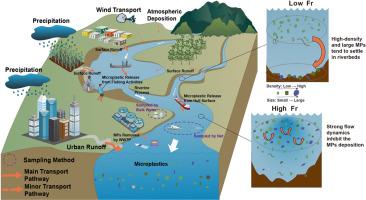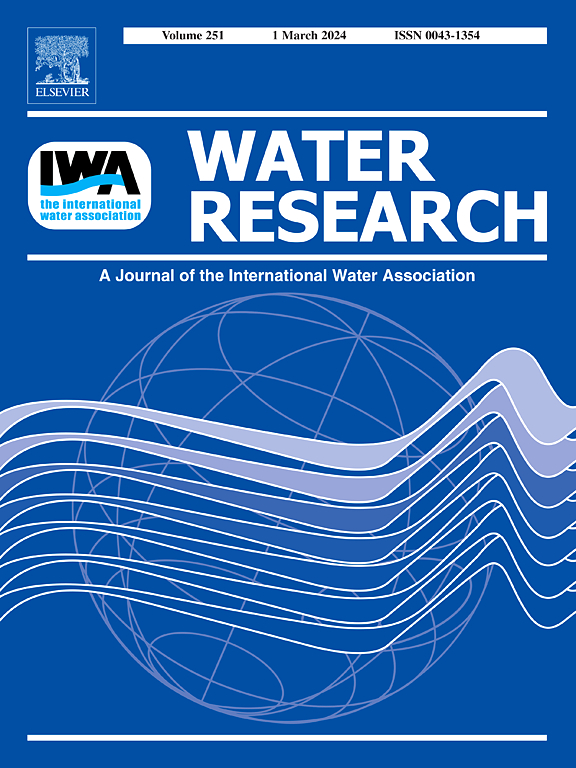Microplastic pollution in Pearl River networks: Characteristic, potential sources, and migration pathways
IF 11.4
1区 环境科学与生态学
Q1 ENGINEERING, ENVIRONMENTAL
引用次数: 0
Abstract
Microplastic (MP) pollution has become a global environmental problem with profound impacts on aquatic ecosystems. Although the topic of MPs has attracted high attention, the sources, transport pathway, and removal of MPs in river networks is still unclear. Here, we conducted a field survey across the Pearl River Basin (PRB) (> 4.5 × 105 km2) and collected the water samples to characterize the spatial distribution of MPs using a Laser Direct Infrared (LDIR) chemical imaging system. The MPs were detected in all samples with an average abundance of 1092.86 items/L, in which polyamide (PA), polyurethane (PU), and polyvinyl chloride (PVC) are the main polymer types. Population and surface runoff were identified as major factors influencing the concentrations of MPs. The Partial Least Squares Structural Equation Modeling (PLS-PM) analysis revealed that precipitation-induced surface runoff is a major pathway for MPs transferring from terrestrial environment to river networks. River hydraulic dynamics were found to have considerable influence on the selective removal of MPs from water column in the river channel. The smooth state (Froude number, Fr <0.23) promotes while the rough state (Fr > 0.23) inhibits the deposition of MPs from water column to sediments. In particular, the smooth state facilitates the deposition of large-sized and high-density MPs from the water column to sediments. The deposition processes in river channel cause considerable fractionation of polymer types and size of riverine MPs. This study provides the first-hand MP pollution status in the networks of the PRB and provide insights into sources, spatial distribution characteristics, and transmission mechanism of MPs in river networks, which would provide theoretical bases and experimental reference for river water quality management and risk control of MPs for governor, stakeholders, and policy makers.


求助全文
约1分钟内获得全文
求助全文
来源期刊

Water Research
环境科学-工程:环境
CiteScore
20.80
自引率
9.40%
发文量
1307
审稿时长
38 days
期刊介绍:
Water Research, along with its open access companion journal Water Research X, serves as a platform for publishing original research papers covering various aspects of the science and technology related to the anthropogenic water cycle, water quality, and its management worldwide. The audience targeted by the journal comprises biologists, chemical engineers, chemists, civil engineers, environmental engineers, limnologists, and microbiologists. The scope of the journal include:
•Treatment processes for water and wastewaters (municipal, agricultural, industrial, and on-site treatment), including resource recovery and residuals management;
•Urban hydrology including sewer systems, stormwater management, and green infrastructure;
•Drinking water treatment and distribution;
•Potable and non-potable water reuse;
•Sanitation, public health, and risk assessment;
•Anaerobic digestion, solid and hazardous waste management, including source characterization and the effects and control of leachates and gaseous emissions;
•Contaminants (chemical, microbial, anthropogenic particles such as nanoparticles or microplastics) and related water quality sensing, monitoring, fate, and assessment;
•Anthropogenic impacts on inland, tidal, coastal and urban waters, focusing on surface and ground waters, and point and non-point sources of pollution;
•Environmental restoration, linked to surface water, groundwater and groundwater remediation;
•Analysis of the interfaces between sediments and water, and between water and atmosphere, focusing specifically on anthropogenic impacts;
•Mathematical modelling, systems analysis, machine learning, and beneficial use of big data related to the anthropogenic water cycle;
•Socio-economic, policy, and regulations studies.
 求助内容:
求助内容: 应助结果提醒方式:
应助结果提醒方式:


